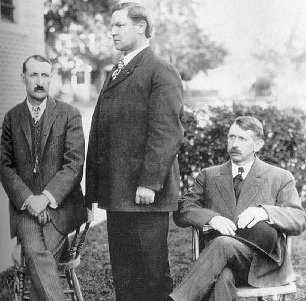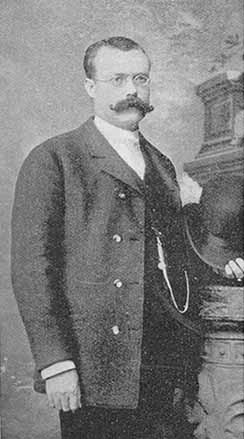
Pinkerton is a private security guard and detective agency established around 1850 in the United States by Scottish-born American cooper Allan Pinkerton and Chicago attorney Edward Rucker as the North-Western Police Agency, which later became Pinkerton & Co, and finally the Pinkerton National Detective Agency. It is currently a subsidiary of Swedish-based Securitas AB.

The Western Federation of Miners (WFM) was a labor union that gained a reputation for militancy in the mines of the western United States and British Columbia. Its efforts to organize both hard rock miners and smelter workers brought it into sharp conflicts – and often pitched battles – with both employers and governmental authorities. One of the most dramatic of these struggles occurred in the Cripple Creek district of Colorado in 1903–1904; the conflicts were thus dubbed the Colorado Labor Wars. The WFM also played a key role in the founding of the Industrial Workers of the World in 1905 but left that organization several years later.

William Dudley "Big Bill" Haywood was an American labor organizer and founding member and leader of the Industrial Workers of the World (IWW) and a member of the executive committee of the Socialist Party of America. During the first two decades of the 20th century, Haywood was involved in several important labor battles, including the Colorado Labor Wars, the Lawrence Textile Strike, and other textile strikes in Massachusetts and New Jersey.

Frank Steunenberg was the fourth governor of the State of Idaho, serving from 1897 until 1901. He was assassinated in 1905 by one-time union member Harry Orchard, who was also a paid informant for the Cripple Creek Mine Owners' Association. Orchard attempted to implicate leaders of the radical Western Federation of Miners in the assassination. The labor leaders were found not guilty in two trials, but Orchard spent the rest of his life in prison.
There were two related incidents between miners and mine owners in the Coeur d'Alene Mining District of North Idaho: the Coeur d'Alene, Idaho labor strike of 1892, and the Coeur d'Alene, Idaho labor confrontation of 1899. This article is a brief overview of both events.

George A. Pettibone was an Idaho miner. Pettibone was best known as a defendant in trial of three leaders of the Western Federation of Miners for the 1905 assassination by bombing of Frank Steunenberg, former governor of Idaho.

Edward Boyce was president of the Western Federation of Miners, a radical American labor organizer, socialist and hard rock mine owner.
The Silver Valley is a region in the northwest United States, in the Coeur d'Alene Mountains in northern Idaho. It is noted for its mining heritage, dating back to the 1880s.

James McParland was an American private detective and Pinkerton agent.

The Colorado Labor Wars were a series of labor strikes in 1903 and 1904 in the U.S. state of Colorado, by gold and silver miners and mill workers represented by the Western Federation of Miners (WFM). Opposing the WFM were associations of mine owners and businessmen at each location, supported by the Colorado state government. The strikes were notable and controversial for the accompanying violence, and the imposition of martial law by the Colorado National Guard in order to put down the strikes.
Labor spying in the United States had involved people recruited or employed for the purpose of gathering intelligence, committing sabotage, sowing dissent, or engaging in other similar activities, in the context of an employer/labor organization relationship. Spying by companies on union activities has been illegal in the United States since the National Labor Relations Act of 1935. However, non-union monitoring of employee activities while at work is perfectly legal and, according to the American Management Association, nearly 80% of major US companies actively monitor their employees.

Burke Canyon is the canyon of the Burke-Canyon Creek, which runs through the northernmost part of Shoshone County, Idaho, U.S., within the northeastern Silver Valley. A hotbed for mining in the late-nineteenth and twentieth centuries, Burke Canyon now contains several ghost towns and remnants of former communities along Idaho State Highway 4, which runs northeast through the narrow canyon to the Montana border.
In the United States, a Mine Owners' Association (MOA), also sometimes referred to as a Mine Operators' Association or a Mine Owners' Protective Association, is the combination of individual mining companies, or groups of mining companies, into an association, established for the purpose of promoting the collective interests of the group. Such associations are sometimes referred to as MOAs, however, in some cases they may be designated by the state, district, or locale, such as the Cripple Creek District Mine Owners' Association (CCDMOA).

The history of union busting in the United States dates back to the Industrial Revolution in the 19th century. The Industrial Revolution produced a rapid expansion in factories and manufacturing capabilities. As workers moved from farms to factories, mines and other hard labor, they faced harsh working conditions such as long hours, low pay and health risks. Children and women worked in factories and generally received lower pay than men. The government did little to limit these conditions. Labor movements in the industrialized world developed and lobbied for better rights and safer conditions. Shaped by wars, depressions, government policies, judicial rulings, and global competition, the early years of the battleground between unions and management were adversarial and often identified with aggressive hostility. Contemporary opposition to trade unions known as union busting started in the 1940s, and continues to present challenges to the labor movement. Union busting is a term used by labor organizations and trade unions to describe the activities that may be undertaken by employers, their proxies, workers and in certain instances states and governments usually triggered by events such as picketing, card check, worker organizing, and strike actions. Labor legislation has changed the nature of union busting, as well as the organizing tactics that labor organizations commonly use.
The Leadville miners' strike was a labor action by the Cloud City Miners' Union, which was the Leadville, Colorado local of the Western Federation of Miners (WFM), against those silver mines paying less than $3.00 per day. The strike lasted from 19 June 1896 to 9 March 1897, and resulted in a major defeat for the union, largely due to the unified opposition of the mine owners. The failure of the strike caused the WFM to leave the American Federation of Labor (AFL), and is regarded as a cause for the WFM turn toward revolutionary socialism.
The Coeur d'Alene, Idaho, labor riot of 1899 was the second of two major labor-management confrontations in the Coeur d'Alene mining district of northern Idaho in the 1890s. Like the first incident seven years earlier, the 1899 confrontation was an attempt by union miners, led by the Western Federation of Miners to unionize non-union mines, and have them pay the higher union wage scale. As with the 1892 strike, the 1899 incident culminated in a dynamite attack that destroyed a non-union mining facility, the burning of multiple homes and outbuildings and two murders, followed by military occupation of the district.

Anti-union violence is physical force intended to harm union officials, union organizers, union members, union sympathizers, or their families. It is most commonly used either during union organizing efforts, or during strikes. The aim most often is to prevent a union from forming, to destroy an existing union, or to reduce the effectiveness of a union or a particular strike action. If strikers prevent people or goods to enter or leave a workplace, violence may be used to allow people and goods to pass the picket line.
Pearl Louis Bergoff was an American strikebreaker noted for violent tactics from the early 1900s through the 1930s.

Anti-union violence in the United States is physical force intended to harm union officials, union organizers, union members, union sympathizers, or their families. It has most commonly been used either during union organizing efforts, or during strikes. The aim most often is to prevent a union from forming, to destroy an existing union, or to reduce the effectiveness of a union or a particular strike action. If strikers prevent people or goods to enter or leave a workplace, violence may be used to allow people and goods to pass the picket line.

John Aylard Finch was an affluent English immigrant, businessman and philanthropist in the Inland Northwest region of the United States.














